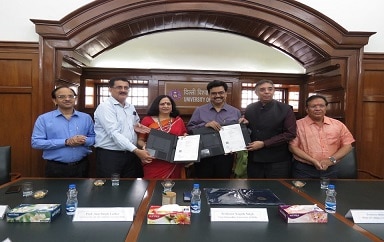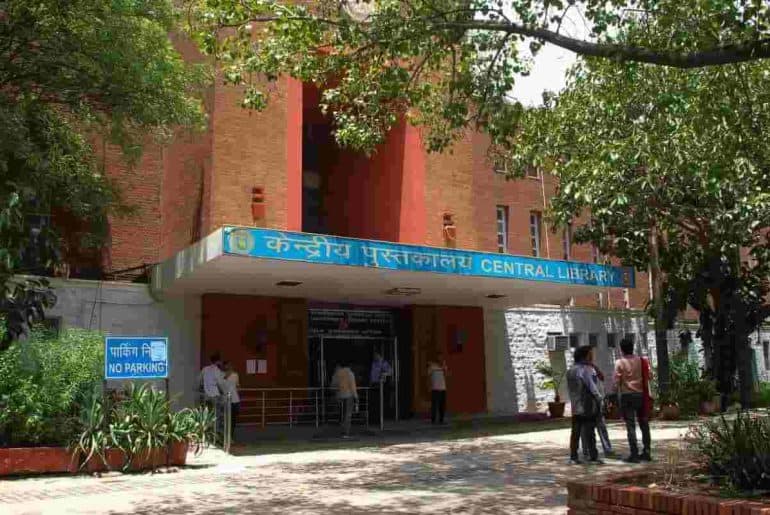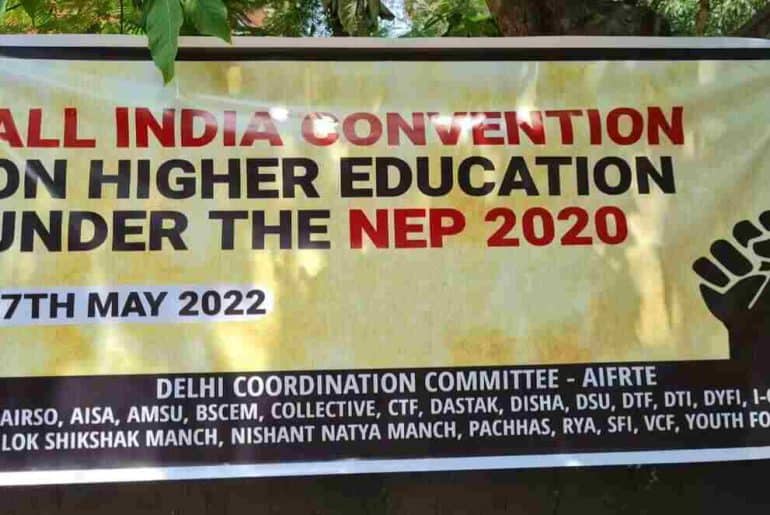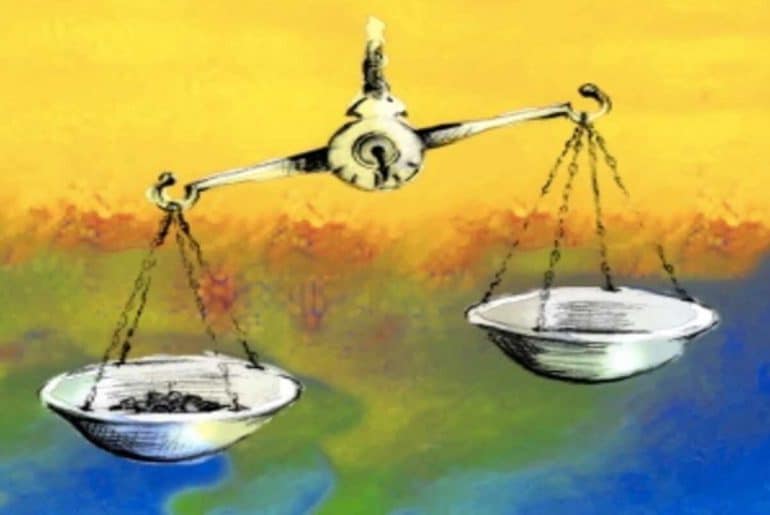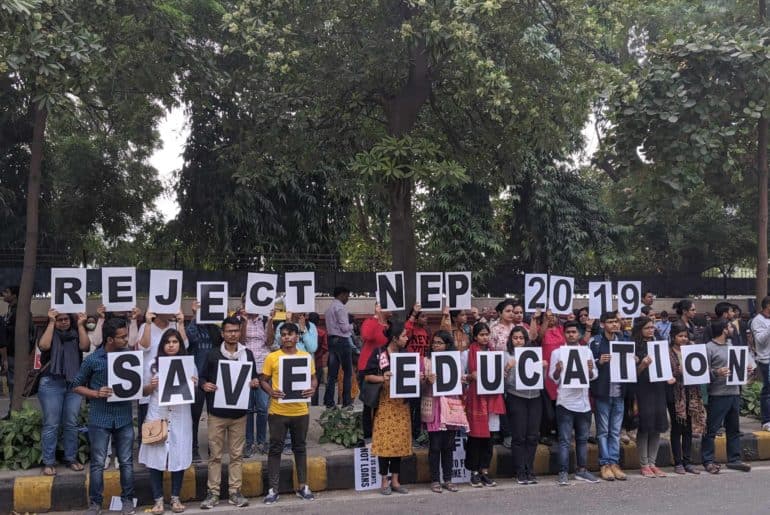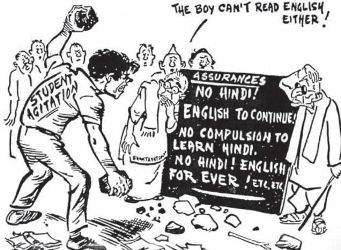An ‘All India Convention on Higher Education Under the NEP 2020’ was hosted by AIFRTE to deliberate upon the New Education Policy (2020). The event included a long list of educationists, coming from various parts of the country, who presented their views on the subject. Read ahead to find out more.
The All India Forum for Right to Education (AIFRTE) organised an ‘All India Convention on Higher Education Under the NEP 2020’, on 27 May 2022 at the Gandhi Peace Foundation. The event was attended by renowned educationists and professors, who came from various parts of the country to deliver speeches on a subject of shared interest. Various student and teacher organisations including All India Students’ Association (AISA), Students’ Federation of India (SFI), Collective, and Democratic Teachers’ Front (DTF) were also present, among others.
Among the first speakers, who were scheduled to speak in the First Session, Mrigank delivered his speech on ‘NEP 2020: Background and Purpose’. He is the Senior Vice President, IFTU, National Executive Member, AIFRTE, and Convenor, People for Science (Delhi). Through his speech, he stressed on how the policy is a ‘complete corporatization of education’. He stated that the entire document reflects a budget cut of the government and further claimed that this policy would give birth to a population of ‘zombies’ who would not have a mind of their own.
Following this, Professor. Surjeet Majumdar, who is a Professor of Economics at Jawaharlal Nehru University (JNU) and a former secretary of JNUTA, spoke on the subject, ‘Killing several birds with one stone: Higher Education in NEP 2020’. Professor Majumdar asserted that neither there is an increase in the public expenditure on education nor there is an increase in Gross Domestic Product (GDP). With his speech, the first session culminated for a short break of a few minutes.
Beginning the next session was Professor Minati Panda, who is a professor at Zakir Husain Centre for Education Studies, JNU. She made her speech on ‘The Question of Language and epistemic justice in Higher Education in NEP 2020’. The Professor found the policy to be a ‘verbose document’. She stressed the subject of multilingualism, claiming that when someone goes around the first few pages of the policy, they ought to find it in contradiction to the realistic experiences.
Multilingual education is going to end the concept of multilingualism in the future.” –Professor Minati Panda
Continuing this flow, the next speaker was Joga Singh. He is a former Professor of Linguistics at Punjabi University, Patiala, Punjab. He took upon the subject ‘Bankrupt Language Proposals in NEP 2020’. He strongly voiced his thoughts on the language section of the policy. He stated that the policy says that students will have to study three languages ‘wherever possible’. Stressing on the latter part, he claimed that the phrase ‘wherever possible’ here simply means ‘nowhere possible’. To support his notion, he asserted that people get jobs only with knowledge of English and a majority of parents prefer sending their children to an ‘English-medium school’.
Privatisation and Commercialisation stands on english and the entire policy talks about them so english is nowhere to go.” -Joga Singh
The next speaker was Professor Madhu Prasad. She is a former Professor of Philosophy at Zakir Husain College, University of Delhi (DU), Spokesperson, and Presidium member, AIFRTE. She spoke about ‘NEP 2020 and digitalisation of education’ and she found it to be unfortunate that when the pandemic hit, the government rushed to shut down schools and colleges, even before malls and parks were closed. She believes that the government had already planned this NEP and hence used the period of the pandemic to give it a further push.
Digitalisation is talked about as a technique but instead it is a process through which one makes knowledge a merchandise.” -Professor Madhu Prasad
The session was resumed with Dr. Shamsul Islam, a former professor from Delhi University. Following him, Dr. Maya John, who teaches history at Jesus and Mary College, Delhi University, spoke on the ‘Rhetorics and realities of higher education in NEP 2020: a critique of UGCF from the margins’.
When the constitution was being drafted and Right to Education was removed from the Fundamental Rights and put into the Directive Principles of State Policy, why was it not questioned?” -Dr. Maya John
She talked about how this policy was a “part and product of the international milieu”, something that will help in the creation of labour with multiple skills, aiding only “the global elitist needs”. She also brought out the contradictions that exist in the NEP 2020 and focusing on how the guarantee of education from 6 to 14 years of age is not enough, demanded:
Nothing short of education from KG to PG— public funded education from KG to PG.”
Representing Jamia Millia Islamia, Dr. Shikha Kapur, went on to talk about how education is moving towards centralisation and towards capitalism, and questioned the UGC’s step aiming towards uniformity through NEP.
But when the country is diverse… where will uniformity come from in this diversity?” -Dr. Shikha Kapur
She went on to talk about how the education policy has led to the quantification of education, with social sciences and languages also being marked on the basis of MCQs, and how CUET will block the pathway of education for many groups, including first-generation learners.
Dr. Shikha Kapur was followed by Prof. Nandita Narain, Professor at St. Stephen’s college, DU, and former president, DUTA and FEDCUTA, who spoke on the ‘Degradation of quality through restructuring of academic courses (FYUP, UGF, ABC, CUET) and governance (fragmentation, corporatisation, privatisation, and exclusion)’. She talked about the condition of education during the years of lockdown and how this step towards digitalisation will again push us back into the same dark tunnel.
Speaking against the CUET, she brought attention to how this will only aid institutions in earning more money and also spoke in disfavour of the recent CUET crash course organised by Ramanujan College.
This [NEP 2020] is a privatisation blueprint’” -Prof. Nandita Narain
Dr. Abha Dev Habib, who teaches Physics at Miranda House, DU; Secretary, DTF; former treasurer, DUTA; and former member of the executive council, DU, spoke on ‘CUCET, FYUP, and UGF: Illusion of choices’. Comparing NEP to a packet of chips, she says “Jiske pass jitna paisa hai, valise hi chips ka packet kharidega, aur kitne log hain jo wahan tak pahunch bhi nhi payenge”.
She brought attention to the fact that when students opt for the multiple exit option, exiting after three years, they will still be considered drop-outs under the FYUP. She went on to call the students to fight against the NEP 2020.
Agar Modi Sarkar ko kisi ne lalkara hai toh woh students hain ” -Dr. Abha Dev Habib
Representing Ambedkar University, Dr. Shivani Nag, spoke on the ‘fallacy of gender inclusion in NEP’ and the contradictions with the NEP 2020.
3 saal ki degree kafi nahi hai, 4th saal chahiye par 1 saal ke baad students chhod sakte hain [talking about the multiple exit options].” -Dr. Shivani Nag
Jagmohan Singh, Chairperson, AIFRTE; General Secretary, AFDR, Punjab; and Director, Shaheed Bhagat Singh Creativity Centre, Ludhiana, talked about ‘How NEP is contrary to the legacy of the freedom struggle: Need for students’ and youth’s movements.
If centralisation is happening from top, then only an effort by people from below can contradict it.” -Jagmohan Singh
In a press statement released by AIFRTE on 28th May 2022, the event was concluded with a call for active mobilisation against NEP.
While these grave and burning issues surround the current policy, the progressive and pro-democratic forces of the country resolve to fight for equal, free, and quality education for all. We demand immediate annulment of the National Education Policy 2020. The BJP-RSS’s agenda for communalisation, de-academisation and privatization of education must be fought by mobilizing students, teachers, parents, and communities. AIFRTE unequivocally demands revocation of this irrational course structure. Else, students, teachers and parents will go on resisting this programme without any compromise.” -press statement, AIFRTE.
Read also “Insult, Injury & Illness: DU’s Offline Exams”
Feature Image: DU Beat Archives
Ankita Baidya
[email protected]
Manasvi Kadian
[email protected]

